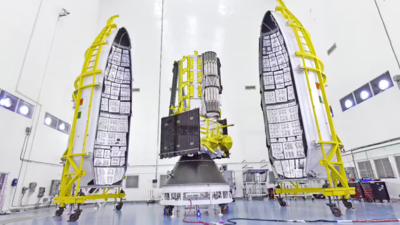ARTICLE AD BOX

BENGALURU: Following the $1.5 billion Nasa-Isro Synthetic Aperture Radar (Nisar) mission, Nasa and Isro could soon start discussing areas of common interest for another joint mission although there’s nothing concrete decided at this juncture.Karen St Germain, Director of Earth Science, Nasa headquarters, answering a question on whether there would be a follow-up mission, said late on Monday: “…We have been so focussed on getting Nisar completed and into orbit and extracting the incredible science and applications from the mission that we don’t have a mission lined up at the moment. But I assume we will start talking about common interests on our next mission in the near future.
” Nasa hinting at a possibility of another joint mission points to a growing alignment between the two space agencies not just in human spaceflight or lunar exploration but also in Earth observation and climate monitoring — areas where both countries see strategic and scientific value.
Powerful team
With Nisar fully ready for launch — lift off is scheduled for 5.40pm Wednesday aboard GSLV-F16 — Nasa and Jet Propulsion Laboratory (JPL) officials reflected on the nearly decade-long collaboration that has brought Indian and American engineers into close quarters.
“We’ve worked this intimately where they [Isro teams] spent years at our facility and we spent years at theirs,” Phil Barela, Nisar project manager from JPL, said, describing the partnership as deeply integrated.He noted that while the two agencies often approached problems differently, the teams stayed open-minded and eventually developed a strong working rhythm. “It is an extremely powerful team at this point and not something we’d trade for the world,” Barela added.Karen, while recognising the leadership of Isro and JPL team, said building a satellite on opposite sides of the world during a global pandemic was really hard, but it strengthened the relationship with Isro. “The collaboration, the cooperation, information sharing, and, frankly, joint learning between our two agencies is a foundation that we look forward to continuing to build upon,” Karen said.Barela added that during the height of Covid, about 65 Isro engineers visited JPL and worked to keep the integration and tests going.
“...And over the last two-and-a-half years, Nasa has sent out over 175 engineers to Isro’s facilities to keep the integration and tests going and get us ready for where we stand today and ready for launch.”
Isro cost model different
Financially, Nasa has invested about $1.2 billion over the primary life of the mission. However, Karen refrained from comparing costs directly with Isro, saying the Indian agency follows a different accounting model.
“...So it's really difficult to draw comparisons based on money alone,” Karen noted.Instead, she highlighted the equitable hardware and operations contributions from both sides. Nasa developed the L-band radar system and related subsystems, while Isro built the spacecraft bus, S-band radar, solar arrays, and is handling launch and mission operations. A standout component of the spacecraft is the nearly 40-foot deployable antenna and boom, an engineering feat integrated across teams.“This is a completely joint and integrated mission,” Karen said, emphasising that Nisar reflects a level of collaboration that is rare in large-scale satellite missions.



.png)
.png)
.png)
















 12 hours ago
5
12 hours ago
5








 English (US) ·
English (US) ·